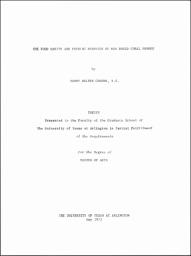
ATTENTION: The works hosted here are being migrated to a new repository that will consolidate resources, improve discoverability, and better show UTA's research impact on the global community. We will update authors as the migration progresses. Please see MavMatrix for more information.
Show simple item record
| dc.contributor.author | Greene, Harry Walter | |
| dc.date.accessioned | 2021-01-08T14:20:20Z | |
| dc.date.available | 2021-01-08T14:20:20Z | |
| dc.date.issued | 1973-05-01 | |
| dc.identifier.uri | http://hdl.handle.net/10106/29657 | |
| dc.description.abstract | This thesis considers the food habits and feeding behavior of New
World venomous coral snakes, with emphasis on Micrurus fulvius a species
that is found in the southeastern United States and northern Mexico. Literature
records and the stomach contents of preserved specimens demonstrate that
M. fuIvius of all sizes are specialized tertiary consumers. In Texas, they
feed mostly on several species of small, secretive colubrid snakes and on
skinks of the genera Eumeces and Leiolopisma. Other kinds of lizards and the
young of large colubrid and viperid snakes make up the remainder of their
prey. Geographic and seasonal variations in the diet ref lect the distribution
and availability of particular prey species. The data from other parts of the
range do not show differences from the pattern observed in Texas.
A preliminary ethogram f or Micrurus fulvius includes 26 action
patterns and two orienting movements, and many of these elements are used in
feeding behavior. Coral snakes use stereotyped searching movements to find
food in litter and to follow prey trailso Visual and chemical stimuli elicit
attack, and the prey is held until it is immobilized by the venom. Pre-ingestion
movements are inhibited by the prey's struggles and directed by scale overlap.
Swallowing is head first, and includes movements of the entire head of the
coral snake as well as individual jaw elements. The feeding behavior is interpreted
as being intermediate between a simple colubrid method and the highly
specialized viperid type.
Data are presented on the food habits of 26 other New World elapids.
They are known to eat onycophorans, eels, caecilians, amphisbaenians, lizards,
and snakes. The feeding
and M® distans
behavior of Micruroides
is similar to that of M.
euryxanthus , Micrurus corallinus
fulvius. Micrurus frontalis and perhaps M. 1emniscatus bite, release, and relocate prey prior to swallowing,
but the reason for this apparent innovation is unknown.
Morphological, behavioral, and ecological similarities between Old
and New World coral snakes may ref lect the phylogeny and zoogeography of the
snakes or represent convergence and equivalence. It is suggested that sympatry
among New World species might be uncormon or accompanied by size differences. | en_US |
| dc.language.iso | en_US | en_US |
| dc.publisher | University of Texas at Arlington Libraries | en_US |
| dc.title | The Food Habits and Feeding Behavior of New World Coral Snakes | en_US |
| dc.type | Thesis | en_US |
Files in this item
- Name:
- Food_Habits_and_Feeding_Behavi ...
- Size:
- 37.31Mb
- Format:
- PDF
- Description:
- PDF
This item appears in the following Collection(s)
Show simple item record


